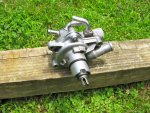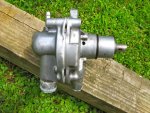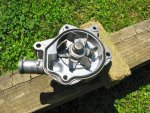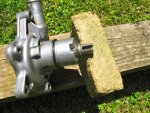bicyclist
Guest
When I was doing a valve check the other day, I noticed that the coolant was low in the expansion tank. After finishing the work, I crawled underneath and cleaned up the water pump, then took the bike for a ride. Upon returning, inspection of the pump revealed some leakage from the weep hole. Honda (and most manufacturers) says that a small amount of weepage from the bleed hole is normal. The question is, what's the difference between a weep and a leak? Figuring that it wouldn't get better (I'm smarter than the average chicken), I decided to replace the pump.
The pump can be ordered as a complete assembly or individual parts. I decided to get the complete assembly and ordered from Ron Ayers for $92. The part showed up yesterday and I got a gallon of Honda coolant from the auto dealer.
It's necessary to remove the middle cowl to get to the radiator cap. The book fails to mention a screw under the meter cover which must come out. Once the tupperware is off, the radiator cap is removed and coolant drained by removing a bolt on the pump. The book tells you to also remove a bolt on the crankcase, but that's incorrect. The book also doesn't tell you to drain the oil, but you'll be in for a surprise when you pull the pump if you don't. Next, the five water hoses are disconnected from the pump. The book tells you to remove the pump cover next, but there's no reason to do so. Removal of two bolts allows the pump assembly to be pulled out of the crankcase.
The new pump assembly comes with a new o-ring. Oil it up and insert the pump into the crankcase, aligning its groove with the projection of the oil pump shaft. Torque the two bolts to 13 nm and check the others. Reconnect the five hoses and slowly pour 2 quarts of coolant into the radiator. Squeezing the large radiator hose connected to the pump will help burp the system. Refill the expansion tank and engine oil. Run the engine for a bit, check that coolant is up to the filler neck and cap it off. Reinstall the tupperware. You'll discover that the hole in the pump for one of the bolts that holds on the plastic cover is not tapped. The three bolts that hold on that plastic are self tapping, so with a little care, you can run the bolt into the pump and create some threads. Go for a test ride and check your work.
The pump can be ordered as a complete assembly or individual parts. I decided to get the complete assembly and ordered from Ron Ayers for $92. The part showed up yesterday and I got a gallon of Honda coolant from the auto dealer.
It's necessary to remove the middle cowl to get to the radiator cap. The book fails to mention a screw under the meter cover which must come out. Once the tupperware is off, the radiator cap is removed and coolant drained by removing a bolt on the pump. The book tells you to also remove a bolt on the crankcase, but that's incorrect. The book also doesn't tell you to drain the oil, but you'll be in for a surprise when you pull the pump if you don't. Next, the five water hoses are disconnected from the pump. The book tells you to remove the pump cover next, but there's no reason to do so. Removal of two bolts allows the pump assembly to be pulled out of the crankcase.
The new pump assembly comes with a new o-ring. Oil it up and insert the pump into the crankcase, aligning its groove with the projection of the oil pump shaft. Torque the two bolts to 13 nm and check the others. Reconnect the five hoses and slowly pour 2 quarts of coolant into the radiator. Squeezing the large radiator hose connected to the pump will help burp the system. Refill the expansion tank and engine oil. Run the engine for a bit, check that coolant is up to the filler neck and cap it off. Reinstall the tupperware. You'll discover that the hole in the pump for one of the bolts that holds on the plastic cover is not tapped. The three bolts that hold on that plastic are self tapping, so with a little care, you can run the bolt into the pump and create some threads. Go for a test ride and check your work.




